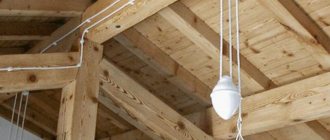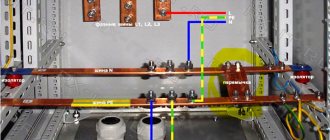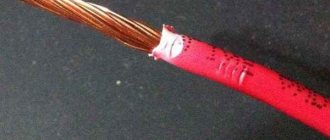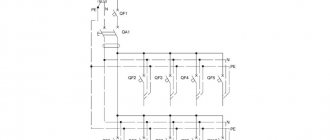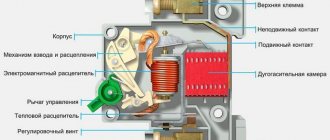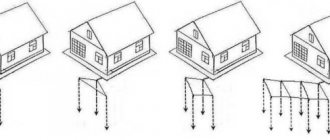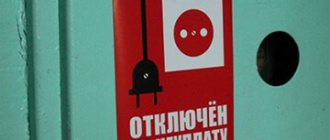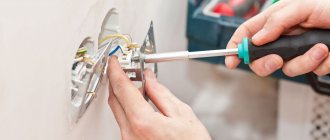If you are very lucky, then in your private home the electrical network is always stable, and its voltage corresponds to the nominal 220 V with a permissible deviation of ±10%, according to GOST 29322-92 as amended in 2014. Unfortunately, this is not always the case. In the evening, light bulbs glow dimly, and sometimes, due to overvoltage, expensive household appliances and electronics fail. A voltage stabilizer will help save the situation, and I will tell you how to choose a voltage stabilizer for a private home.
Causes of overvoltage
The normal voltage for a single-phase network in an apartment is the well-known 220 V , but GOST 29322-2014 provides for a small error - within 10% , i.e.
the voltage in our networks can fluctuate from 198 to 242 V. Everything higher and lower already carries various kinds of danger. Where do power surges in the network come from? There are several reasons:
- lightning strikes a substation, power line or elements of a house , and its current strength reaches 200 kA;
- welding work , turning on powerful equipment or simultaneous operation of numerous electrical appliances in an apartment building;
- breakage of the zero contact , as a result of which the voltage can jump from 110 to 360 V. One of the reasons for the breakage of the zero contact lies in the increased amount of equipment used. Many houses were designed and built when there were not so many electrical appliances. Today, in the morning hours in every home, a lot of equipment is turned on: stoves, kettles, vacuum cleaners, washing machines, heaters, boilers, etc. Often the wires work at the peak of their capabilities, therefore they overheat in the morning and evening, then cool down greatly, and as a result the conductor weakens, and the zero contact may even burn out;
- broken wires due to bad weather, accident . The voltage in the network can suddenly skyrocket several times;
- incorrect connection of wires in the panel;
- failures in the operation of the power plant.
High voltage can cause a spark to appear in the dielectric layer, followed by the appearance of an electric arc, which is fraught with fire. Too low a voltage is also dangerous . The refrigerator, for example, will be harder to start, which will affect its performance.
Most devices are designed to operate at a voltage of approximately 200-240 V, but frequent, albeit not very large, deviations from the “ideal” 220 V affect durability. If something “burns out” due to overvoltage, then the repair is not covered by the warranty.
To protect your apartment and house from the adverse effects of power surges in the network, the following principles are used:
- power outage due to a sudden increase in voltage;
- output of excess electrical potential to the ground loop;
- stabilization of the incoming voltage to an ideal 220 V.
Of course, to protect your home network, it is better to take a comprehensive approach and carry out a complete reconstruction of the electrical system, but in an apartment building, for example, this is extremely difficult to do. Dozens of residents will simply never come to a common opinion and agree on joint payment, so they will have to act locally - at the level of their own apartment. In this regard, it is a little easier for owners of a private house.
Will traffic jams or automatic machines help? For a long time, plugs were the only protection against short circuits and overheating. They were replaced by more convenient circuit breakers. Of course, they are needed and in a number of situations they protect the network, but they cannot save you from the consequences of a lightning strike or high voltage.
Will traffic jams or automatic machines save the day?
Circuit breakers and their earlier analogues, safety plugs, are protection devices against short circuits and long-term overloads. Their protective operation occurs only when the current in the circuit exceeds a certain value for an unacceptably long time, which may not be reached during a power surge.
As a result, traffic jams and machines will either not work at all, or will work after a long period of time, so such products can hardly be considered as serious protection against network surges and fluctuations.
Voltage control relay
The voltage control relay (VCR) works quite simply.
It constantly measures the voltage, compares the obtained readings with acceptable values, and when there is a noticeable increase in voltage, it simply stops supplying power. Please note that the relay cannot equalize the voltage. When the voltage readings return to normal, the relay will again “pass” electricity to electrical appliances. Returning to normal operation occurs with some delay necessary for large household appliances to start correctly. Turning off the power occurs almost at lightning speed - the relay requires only 2-3 ms.
The relay can be made in two versions :
- a block that is installed in the distribution panel on a DIN rail;
- a device resembling an extension cord , with sockets for sockets.
The most common and effective way is to install the relay in the panel. In this case, it is better if the RKN is installed before installing the meter, so that this equipment is also protected from voltage surges. Despite the relative ease of installing a relay, it is still better to entrust electrical installation work to specialists who will do everything quickly and efficiently, observing the standards and agreed deadlines.
Advantages of using a voltage relay:
- the device does not take up much space;
- works quietly;
- is inexpensive;
- ease of installation and connection;
- the relay consumes extremely little electricity;
- display of voltage readings in real time.
Minuses:
- not suitable for homes with constant power surges, otherwise regularly turning off all appliances will very soon drive you crazy. This is not a minus, but rather a feature of the work that determines the scope of use of the relay - houses and apartments with rare voltage surges;
- cannot protect against a surge when struck by lightning. If during a lightning strike the relay is hit by a lightning impulse, it will be damaged. The impulse will travel further along the wiring and ruin all those devices that are connected to the network (even if they are not working at that moment).
Five of the best relay stabilizers with power up to 1 kW
Low-power stabilizers, as a rule, are used to provide high-quality voltage to individual electrical appliances, such as televisions, computers, office equipment, and other expensive equipment.
BASTION Teplocom ST-555-I
BASTION Teplocom ST-555-I voltage stabilizer
Manufacturer: Russian Federation Cost : about 4,400 rubles A simple and fairly reliable stabilizer, designed for a load of 400 V/A. This is sufficient to supply voltage to equipment equipped with highly sensitive electronic components. Due to its small size, the device can be placed on a shelf or hung on the wall. Output parameters are displayed on a digital display. The maximum deviation from 220 V is no more than 9%. A sinusoidal signal without noise and distortion creates optimal conditions for the operation of electronic equipment.
According to user reviews, the reliable relay mechanism operates at a speed of about 20 ms, providing overvoltage protection. When the threshold values are reached, the protection system turns off the power supply to the load. The build quality and survivability of the device received good marks from users. The manufacturer's warranty for BASTION Teplocom ST-555-I stabilizers is 5 years.
Energy ARS-1000
Energy ARS-1000
Manufacture – Russian Federation Cost – about 4200 rubles
According to user reviews, this stabilizer does an excellent job of regulating the network voltage with an error of up to 4%. This allows the device to be used to power equipment of any complexity level. Most often, this model is used to protect gas boilers, the electronic “filling” of which is extremely sensitive to problems in the electrical network.
The stabilizer is distinguished by its reliability and high build quality. Thanks to the use of high-quality components, the device is distinguished by its durability. The device is equipped with two outputs for connecting electrical appliances with a total power of no more than 1 kW/A.
The response time of the relay system is about 10 ms, which ensures reliable protection of connected electrical appliances.
Stabilizers Energy ARS-1000 are an excellent solution not only for city apartments, but also for country houses and summer cottages, where problems with power supply are especially pressing. A high-quality and inexpensive device will reliably protect connected electrical appliances from voltage surges, short circuits and stray currents.
Resanta ASN 1000/1 C
Resanta ASN 1000/1 C
Manufacture – Latvia Cost – about 2000 rubles
The most popular stabilizer in this segment today is a device produced by Resanta. The Resanta ASN 1000/1 C model is in great demand among buyers due to its quality and affordable price.
The input voltage range of the device is from 140 to 260 volts, the error is about 8%. The stabilizer is equipped with protection systems against overheating and interference. This device, quite simple in design, with a power of up to 1 kW, will be the optimal solution to the problem of protecting household electrical appliances.
The disadvantages of the model include the presence of only one output socket. Negative reviews also include problems with the correct display of voltage parameters. Often the display shows a voltage of 220 volts, while when measured with a multimeter a different value is recorded - 215 or 225 volts.
However, it should be borne in mind that such errors are allowed by current standards, and this is not a drawback of the stabilizer. In conclusion, we note that this model is assembled in Latvia, which sets the stabilizer’s build quality apart from numerous Chinese analogues.
PS Online store where the Resanta brand is sold.
Powercom TCA 2000
Powercom TCA 2000
Manufacture – Taiwan Cost – about 2000 rubles
In second place in our rating is the compact model Powercom TCA 2000, made in Taiwan. This is the smallest stabilizer in the segment under consideration. The stabilizer, which weighs only 1.8 kg, can be placed almost anywhere - on a computer table, next to a gas boiler, near the TV.
The device is assembled according to a classical scheme, which is based on an autotransformer with windings switched by means of a relay. Note that the device in question has the best stabilization indicator in the rating - the alignment error of the Powercom TCA-2000 is only 5%, while most competitors provide stabilization within 8%. An important advantage of the device is its affordable price - the stabilizer can be purchased for less than 2,000 rubles.
1.Quattro Elementi Stabilia W-Slim 1000
Quattro Elementi Stabilia W-Slim 1000
Manufacture – Italy Cost – about 2500 rubles
The leader in the rating of relay devices with a power of up to 1 kW is the Italian stabilizer Quattro Elementi Stabilia W-Slim - 1000. This reliable and high-quality device will provide protection for ventilation and air conditioning systems, gas boilers with electronic control units, household refrigerators, televisions, and office equipment.
Owners of the device pay attention to the compactness and ergonomics of the stabilizer. The ability to wall mount the device allows you to get rid of a lot of hanging wires. The appearance of the stabilizer also received positive reviews - the compact body with a digital indicator fits organically into the interior of any room. The power cable and socket for connecting the load are located on one of the side walls, which allows you to hide all power cables in a special box.
Five of the best relay stabilizers with power up to 10 kW
Relay stabilizers with a power of up to 10 kW attract buyers with the possibility of reliable protection of the home electrical network and their relatively affordable cost. Below we present the five best devices in this segment.
5. Wester STW 10000 NP
Wester STW 10000 NP
Manufacture - Russia Cost - about 12,000 rubles This device has an excellent response speed even to minor fluctuations in the power supply. The input voltage is stabilized to optimal parameters in less than 0.5 seconds. The operating range of the device is 140-260 volts.
The device is intended for permanent connection to the home electrical network, since its power allows for voltage equalization of the entire house, apartment or small office. The device is capable of protecting any electrical equipment with a total power of up to 10 kW from surges and surges.
The device is equipped with effective protection systems - when the input voltage parameters go beyond acceptable limits, the stabilizer automatically turns off.
If short-term surges occur, the device continues to operate normally. In addition, protection of the home electrical network is provided in the event of a short circuit. The stabilizer is controlled via switches, and all relevant information about voltage parameters is displayed on a digital display.
4. Suntek SNET 11000
Suntek SNET 11000
Manufacture – Russia Cost – about 12,500 rubles
This device is the optimal solution to the problems of power supply in a city apartment or country house. The stabilizer implements several algorithms for protecting the equalization of voltage parameters, which allows you to reliably protect complex household appliances, electronic devices, heating and air conditioning systems.
A special feature of this model is the presence of a Bypass system, which allows you to create a backup power supply line for the load, bypassing the main power supply circuit. The owners of this stabilizer model rate the functionality of the device quite highly - stabilization is carried out with an error of up to 8%, even in cases where the mains voltage drops to 120 volts. When the voltage surges up to 285 volts, the circuit breaker is triggered, disconnecting the stabilizer from the network. The disadvantages of the model include a fairly high noise level during operation, however, high reliability and relatively affordable cost fully compensate for this factor.
Rucelf SRW 12000 L
Rucelf SRW 12000 L
Production – Russia-China Cost – about 16,500 rubles
The third place in the rating in the segment under consideration is occupied by the Rucelf SRW 12000 L stabilizer, whose power is 12000V/A. The higher total power of the device allows you to connect powerful electric motors, pumps and household appliances to it. As for the active power, it is still the same 10,000 W.
This model surpasses competitors in its efficiency of 98%. The device has a start-up delay system, protection against overheating, short circuit and overvoltage. The disadvantages include the inflated cost - the stabilizer costs 30-40% higher than its analogues. Note that this model is the development of Russian engineers, but mass production of the stabilizer is carried out in China.
PS Online store where the Rucelf brand is sold.
2. Daewoo Power Products DW TM 12 kVA
Daewoo Power Products DW TM 12 kVA
Manufacture – South Korea Cost – about 23,000 rubles
The Power Products DW TM 12 kVA stabilizer, manufactured by the South Korean company Daewoo, is a reliable and high-quality device that protects connected electrical appliances from overvoltage, overheating, network interference and short circuits. The device responds to voltage fluctuations in the network in just 2 ms. It is noteworthy that the relay switches almost silently, which makes this device stand out from its rather noisy analogues. Another advantage of this model is its compactness and the ability to wall mount the stabilizer, which allows you to place the device even in the smallest rooms.
The stabilization accuracy parameter of Daewoo Power Products DW TM 12 kVA is 8%, which ensures protection of complex electronics and household appliances. Thanks to its high quality, this model is optimal for connecting expensive electrical equipment, including gas boilers with an electronic control unit, automatic washing machines, and refrigeration units.
The overwhelming majority of device owners rate the reliability and build quality of the Daewoo Power Products DW TM 12 kVA positively. At the same time, even the very high cost of the device is not considered by users to be a disadvantage, since it pays off with the durability and quality of the stabilizer.
PS Online store where the DAEWOO brand is sold.
Quattro Elementi Stabilia 12000
Quattro Elementi Stabilia 12000
Manufacture – Italy Cost – about 13,500 rubles
The leader in the rating, as in the segment of stabilizers with a power of up to 1 kW, is a model produced by the Italian company Quattro Elementi. Due to its high performance parameters and optimal price-quality ratio, the device is highly popular among consumers.
The key advantages of this model are a high efficiency of up to 98%, a wide range of operating voltage ranging from 140 to 270 volts, and the presence of three-stage protection and start-up delay systems allows you to connect asynchronous electric motors to the device.
Among the advantages of this high-power stabilizer model, one should also note the presence of a Bypass system, which ensures the transit of voltage along an autonomous line in the event of emergency situations. The presence of a terminal plate instead of traditional sockets increases the variability of connecting the device to the network.
Among the disadvantages of this model, it should be noted the relatively low accuracy of stabilization (about 8%) and the noise of operation due to the presence of a forced ventilation system. However, these minor shortcomings cannot shake the leading position of this device in our rating.
PS Online store where the Quattro Elementi brand is sold.
Voltage sensor
Its task is the same as that of a relay - if an unacceptable voltage for the network is detected, simply interrupt the supply of electricity to the devices. The principle of operation is slightly different. The sensor is installed together with a residual current device (RCD). If a voltage dangerous to the network is detected, the sensor creates a current leak, and the circuit breaker de-energizes the network in this case.
Surge protection device (SPD)
These devices, unlike relays, can protect the network from rapid and very powerful voltage surges that occur during a lightning strike.
Installing such equipment is not the cheapest pleasure, but all the work will certainly cost less than household appliances. There are two types of SPD:
- overvoltage limiters (OSL). This device is based on a varistor. During normal network operation, when there are no voltage surges on the line, the voltage limiter does not conduct current and has a high resistance. As soon as a crisis situation arises, the resistance of the device’s varistor instantly drops to the very minimum value. Thus, the pulse is sent to the ground loop. The arrester thus limits voltage fluctuations and makes them safe. Equipment and people in the premises are under reliable protection. The surge arrester takes up little space and is widely used in private homes;
- spark and valve arresters are an option for high voltage networks. When a large voltage surge occurs, a breakdown of the air layer occurs, the phase is shorted to ground, and the entire discharge goes to the ground.
Modular surge suppressors are installed in home electrical wiring They are mounted in the distribution panel, so they take up no space at all. At its core, this is the same limiter as what is used in the electrical network. It will only work when a critical situation arises. But it is extremely important that the electrical wiring is grounded. If there is none, then the modular surge arrester will be completely useless.
What type of stabilizer to choose
A stabilizer for a private home can be of the following 4 types:
- relay;
- electronic;
- inverter;
- electromechanical.
Each of these types has its own advantages and disadvantages; let’s consider them in more detail.
Relay
These stabilizers are also called step stabilizers, since the voltage at their output during the regulation process does not change smoothly, but in steps.
They are the most common voltage stabilizers for a cottage, private house or cottage. While the relay stabilizer is operating, the control circuit constantly analyzes the output voltage. If it deviates from the nominal value by an unacceptable amount, the currently switched on relay is switched off and another one is switched on, providing an output closer to the nominal one.
In other words, the windings of the autotransformer are switched using a relay.
Typically, relay stabilizers include 4-5 relays, but I have seen models where there were 8 of them. The more relays, the more accurately the output voltage is maintained, the more expensive the stabilizer and the more often it switches.
Advantages of relay stabilizers:
- relatively low cost;
- small overall dimensions;
- wide permissible range of changes in network parameters;
- short-term (up to several seconds) withstand double overload, and long-term withstand overload of 10%;
- operate in the temperature range from -20 to +40 C;
- insensitive to deviations of the input voltage shape from sinusoidal.
Disadvantages include:
- stepwise change in output voltage, which is clearly visible from the glow of incandescent lamps;
- electromechanical relays are the most unreliable element of the stabilizer;
- noise during operation (you can hear clicks when switching the relay).
Electronic
In these devices, instead of relays, special devices are used - thyristors, which are electronic analogues of electrical relays. The control board analyzes the input voltage and connects the output of the stabilizer to the appropriate winding of the autotransformer, turning on the desired thyristor(s).
Advantages of an electronic stabilizer:
- almost instantaneous response to changes in network parameters;
- longer trouble-free operation compared to relay stabilizers;
- silent operation.
Flaws:
- distortion of the output voltage waveform;
- high price.
Electromechanical
The main element of such stabilizers is a booster transformer with an autotransformer primary winding. The constant voltage across the load is maintained by changing the transformation ratio by moving along the taps of the primary winding of the sliding contact.
The contact is moved by an actuator, which includes an electric motor and a control circuit.
For the vast majority of models of electromechanical stabilizers, the moving contact is a carbon electrode, like a brush in a commutator motor.
Particularly advanced models have a movable roller instead of a carbon electrode, and sometimes more than one. The rollers wear out less, therefore, such devices require less maintenance. Such voltage transformers for private homes can already be recommended for purchase.
Advantages of electromechanical stabilizers:
- extended network regulation range – from 130 to 260 V;
- the voltage waveform across the load is not distorted, only the amplitude changes;
- withstand short-term overload;
- insensitive to network deviations in shape and frequency.
Flaws:
- require periodic maintenance (as the moving contacts wear out);
- failures to operate at low temperatures;
- regulation is carried out with a delay, the stabilizer does not have time to react to short-term peaks and dips, transferring them to the load;
- noise when the electric motor operates during control moments.
Inverter
Inverter, or double conversion stabilizers, are even more effective than electronic ones. The output voltage deviation does not exceed 0.5%, and the frequency is also highly stable.
The principle of operation is based on rectifying the mains voltage, feeding it to an inverter, which generates an alternating voltage (sinusoidal or trapezoidal) supplied to the output, which ensures almost complete independence of the output from the frequency and shape of the input.
These devices are recommended for the most power-critical applications, such as measurement or medical equipment. There is simply no reason to buy such a stabilizer for a country house. Well, perhaps very low-power, exclusively for an expensive gas boiler and a couple of incandescent lamps.
Voltage regulator
The most suitable device if there are frequent voltage drops in the network .
The stabilizer is designed in such a way that it is able to equalize the voltage, maintaining it at the same output value. The limit limits are set at approximately 110 and 250 V. Within these limits, the stabilizer will equalize the voltage, giving the user the required 220 V. If the voltage is lower or higher than the specified values, the power will be automatically turned off. several types of stabilizers
- relay - the simplest, with low power and low price, suitable for use in an apartment;
- servo-drive ones - they are more expensive than relay ones, but in terms of their capabilities they are not particularly superior to relay ones;
- electronic ones are more expensive and durable, have good performance indicators, are able to cope with almost any voltage surges, but they are also not cheap;
- electronic double conversion - the most reliable, most durable, most efficient. If you need to protect expensive equipment, then they are the best choice. The downside is the high price.
When choosing a stabilizer, take into account the voltage limits, as well as the total power of the connected electrical appliances. To avoid mistakes, it is better to turn to specialists for help.
Selection by technical characteristics
To choose a stabilizer, first decide whether you will install it on the entire house/apartment or on a specific device (group of devices). In theory, if there are problems with voltage, it is better to install a voltage stabilizer for the house at the input so that all devices are guaranteed to receive normal voltage. But such equipment costs quite a lot of money - at least $500. So the costs are considerable. This approach is justified if the throws are significant, then this is the best way out, since the equipment may fail.
Local and general stabilizers - the first thing you need to decide on
If the voltage “walks” within small limits and most of the equipment is working normally, and only some part of the more sensitive equipment has problems, it makes sense to install local stabilizers - on specific lines or on individual devices.
By number of phases
The power supply in the house can be single-phase or three-phase. With single-phase (220 V) everything is clear: you need a single-phase stabilizer. If the house/apartment has three phases, there are options:
- If you have equipment that connects to three phases at once, then you need a three-phase voltage stabilizer for your home.
Connection diagram of the stabilizer to a single-phase circuit - If the equipment is connected to only one of the phases, single-phase stabilizers are needed for each of the phases. Moreover, their power does not have to be the same, since the load is usually unevenly distributed.
On three-phase circuits you can put three single-phase
Choosing a voltage stabilizer for your home or cottage using this principle is not difficult. But you definitely need to decide.
Power selection
To choose a voltage stabilizer for your home, the first thing you need to do is calculate its power. The easiest way to identify it is by the machine that is located on the house or line. For example, the input circuit breaker is rated at 40 A. We calculate the power: 40 A * 220 V = 8.8 KVA. To ensure that the unit does not operate at its maximum capacity, a power reserve of 20-30% is taken. For this case it will be 10-11 KVA.
The choice of stabilizer power depends on the total power of the network or devices connected to it
The power of the local stabilizer is also calculated, which we install on a separate device. But here we take into account the maximum current consumption (available in the characteristics). For example, this is 2.5 A. Next, we calculate according to the algorithm described above. But if the equipment has a motor (a refrigerator, for example), then it is necessary to take into account the starting currents, which are several times higher than the standard ones. In this case, the calculated parameters are multiplied by 2 or 3.
When selecting power, do not confuse kVA with kW. In short, 10 kVA in the presence of capacitors and inductances on the load (that is, for real networks almost always) is not equal to 10 kW. The actual load figure is less, and how much less depends on the inductance coefficient (may also be in the characteristics). It’s easy to calculate everything for a specific device - you need to multiply it by a coefficient, but for a network it’s more complicated. Just if you see a figure in kVA, take a margin of about 15-20%. This is approximately the average reactive component.
Stabilization accuracy
The stabilization accuracy shows how “even” the output voltage will be. +-5% is considered acceptable. With this tolerance, domestic equipment works normally, but imported equipment requires a better stabilized voltage. So, all stabilizers that have an accuracy of less than +-5% are great, anything worse is better not to buy.
Stabilization accuracy is one of the first parameters that you need to pay attention to
Input voltage range: limit and operating
There are two lines in the characteristics: the maximum input voltage range and the operating one. These are two different characteristics that reflect different device parameters. The limiting range is the one within which the device will at least somehow adjust the voltage. It won’t always stretch it to normal, but at least it won’t turn off.
The maximum range is not always indicated, but there is a working range
The operating range of the input voltage is precisely the range at which the device must produce the declared parameters (with the same stabilization accuracy).
Load and overload capacity
A very important characteristic that you must pay attention to. The load capacity shows how much load a voltage stabilizer for a home can “pull” when operating at the lower limit. There are models that produce the declared power at 220 V. That is, when it is not needed at all. But at the lower limit of 160 V they can only work with half the load. The result is that when operating at low voltage it can burn out. Even if you took it with power reserve.
Load and overload capacity must be requested additionally. Usually it is not in the technical specifications
Overload capacity is equally important. It shows how long it can work with excess load. This parameter is important even if you took the equipment with a good power reserve. Using this parameter, you can indirectly determine the quality of parts and build quality. The higher the overload capacity, the more reliable the equipment.
Uninterruptible Power Supply (UPS)
Uninterruptible power supplies are often mistakenly called stabilizers. This is fundamentally wrong, since their operating principles are completely different. The UPS does not stabilize the voltage and cannot influence it at all. It has batteries , the charge of which should be sufficient so that the user can smoothly complete work with the equipment during a power outage.
Usually an uninterruptible power supply is a home computer's best friend. Not suitable for protecting the entire network. There is a UPS with a built-in stabilizer . Such devices are capable of leveling out small voltage surges, but they are not cheap.
Network filter
A simple surge filter can protect the equipment connected to it during voltage surges up to 380 V and even 450 V, but for this the filter itself must be of high quality and certainly not the cheapest.
But even in the case of a reliable filter, a voltage of more than 450 V will damage it, but the equipment will remain intact, and you will have to buy a new filter. The surge protector will also be a good protection against impulses that occur during welding, but will not protect against lightning discharge during an impulse. In conclusion, I would like to warn you against skimping on your own safety. You can object by saying that your neighbor does not have any protection against overvoltage, and for many years everything has been fine, but numerous cases of equipment failure and fires due to sudden power surges should convince a competent person of the need to equip adequate protection. What to choose, a relay, stabilizer or surge protector, is up to you to decide, based on your place of residence, the frequency of power surges and the high cost of the equipment used.
The article was written for the site.
Tags:Electricity
Electronic relays
These are probably the cheapest voltage stabilizers that perform stepwise voltage regulation. The main disadvantage of such equipment is that they sometimes click during operation. There are periods when the stabilizer clicks almost all the time. The reason for this could be:
1. One relay is broken or the contacts are burnt; 2. The electrical network is in a deplorable state - there are a huge number of twists and bad contacts, a small cross-section of the wire; 3. Broken controller.
It doesn't matter what the reason is. If the stabilizer systematically clicks, then under such conditions it will very quickly fail.
Relay-type voltage stabilizers are quite convenient for use at home, due to:
1. Switching speeds, which are practically not inferior to electromechanical models; 2. Quite fast response; 3. Very comfortable body, light weight; 4. Very favorable price.
Among the disadvantages are the following: very often the relay fails because the contacts tend to burn: only powerful equipment can be serviced; The output voltage sinusoid is very distorted; They don’t really like overloads.
Such devices are perfect for ensuring uninterrupted operation of a TV, refrigerator, lighting devices, various office equipment, ventilation systems, and air conditioners. So, if you do not have ultra-sensitive equipment that is afraid of frequent and sudden voltage changes, then such stabilizers are very suitable for use in an apartment.

